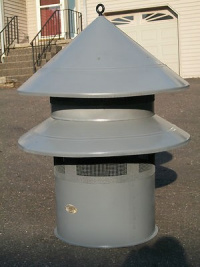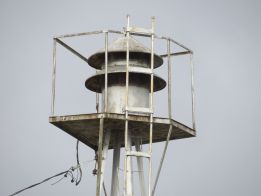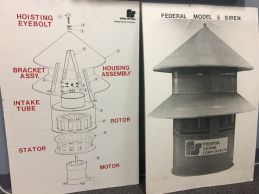Model 5
| Federal Signal Model 3
Federal Signal Model 5 Federal Signal Model 7 | |
 A Federal Signal C2 1/2 Model 5. | |
| Company | Federal Enterprises Company
Federal Sign & Signal Company |
|---|---|
| Produced | 1948-1987 |
| Type | Omnidirectional Electromechanical |
| Sound output | 105-113 dB @ 100 ft |
| Frequency | 50/60 Hz |
| Horsepower | 3-10 hp |
| Voltage | 208-240/480 V 1 or 3 ph |
| Preceded by | Federal Electric Type Mach. B |
| Succeeded by | Federal Signal STH-10 |
| Documentation | Manual |
"Model 5" is used as the article's title due to its common usage by the siren community, as well as referring to a specific name given to 5 horsepower models in this lineup. However, not all sirens in this lineup are called "Model 5". There are many different models that are included in this lineup, which will be discussed below.
The Federal Signal Model 5, also called the General Alarm Siren or Vertical Siren, refers to a line of medium sized omnidirectional sirens produced by Federal Signal over the span of 50 years, going through many design changes and variants throughout that time. Despite being discontinued in 1987, they remain to be extremely common throughout The United States. They were also rebranded and resold by other siren manufacturers, such as GCS and W.S. Darley & Co.
While the Model 2 is part of this lineup, it has its own page and will not be covered in this article. See link for more details.
History
The Model 5 is a line of vertical omnidirectional electric sirens that was produced by the Federal Signal Corporation (originally Federal Enterprises) over a span of four decades and was a design refresh of Federal Electric's Fedelcode series of sirens, which had been discontinued upon Federal Electric's rebranding to Federal Enterprises in 1948. By the time the Fedelcode series had been discontinued, the series had been streamlined to the models "1", "2", "C1 ½" (viz. Model 3), "C2 ½" (viz. Model 5), and "C3 ½" (viz. Model 7, occ. Model 5). The main changes included added screens for the output and intake, and most notably a wider bottom louver. This greatly improved the sirens range, allowing sound to project straight-out instead of funneled towards the ground. Up until 1959, C2 ½ and C3 ½ sized models included a service panel for the motor, which was likely removed as it could fall off and compromise the weatherproof housing.
Like their Fedelcode counterparts, early Model 5 units were available with the option to add a damper, which used a motor-driven (early) or electromagnetic (later) damper to block and unblock the siren's intake, allowing it to produce a "pulse" of noise. This was used to tell volunteer firefighters where a fire was, using a numbered series of "fire zones" and blasting a number of pulses corresponding to which zone the fire was in. These coded models generally have the "OC" suffix, such as the Type 5OC or Type 7OC for example. The option would be dropped by the late 1950s, after code sirens were made obsolete. The design of the sirens was finalized after Federal Enterprises became Federal Sign & Signal in 1955 and would remain largely unchanged throughout the rest of the series' production run.
By the time Federal Sign & Signal had become the Federal Signal Corporation in 1976, the Type C1 ½ and C2 ½ had been discontinued, leaving the C3 ½ as the only model left in production. To simplify the naming scheme, Federal Signal opted to simply name the siren the Model 5, regardless of whether or not it was 5 or 7.5 hp. 10 hp units were usually stamped "Model 7".[citation needed] The 8-port units ceased production around the same time, leaving 12-port single tone and 9/12-port dual tone as the only option until the dual tone option was discontinued in the 1980s.
The Model 5 was discontinued in 1987, due to decreasing sales as fire departments switched to using pagers. The series would partially live on, as the 2001 series uses the 15" rotor from the C2 ½. Federal Signal released the Model ECLIPSE in 2006, which has taken the Model 5's purpose as a general purpose/fire siren while also succeeding the STH-10. Today, the C3 ½ is one of the most common sirens in North America, being found at fire stations, factories, and other places across the continent.
The sirens in this series were also sold by various 3rd party companies who partnered with Federal Signal, such as GCS and W.S. Darley & Co. These sirens had their own custom housings but had identical cores to their basic Federal counterparts, making the differences only cosmetic. These would be produced from the 1940s until around the 1960s.
Design
The Model 5 consists of three different sizes, the C1 ½ (viz. "Model 3"), C2 ½ (viz. "Model 5"), and C3 ½ (viz. "Model 7"), or, as B1 ½, B2 ½, and B3 ½ respectively, on some tags; the difference between them is unclear. Federal named each individual siren by their motor horsepower, as "Type X" and later "Model X" (X being the horsepower). With the exception of the C1 ½, each model came with a variety of different horsepower motors which makes discerning the exact model impossible without knowing the size. The sirens consist of a siren core protected by a weatherproof housing resembling a roof vent, which help to protect the siren core from rain and snow while still allowing sound to project away from the siren. The sirens make use of either an 8 or 12-port single tone rotor and stator, powered by a motor of varying horsepower. 12-port is by far the most common, as it was the standard. 9/12-port dual tone became available as an option for civil defense purposes, though only on C2 and C3 models. Dual tone models are given the T or TT suffix.
C1 ½

The C1 ½ was the smallest sized siren in the lineup, aside from the Models 1 and 2. The C1 ½ bridges the gap between the small Model 2 and the larger sirens in the series and was only a small step up from the Model 2. The C1 ½ makes use of a 13" aluminum rotor, which was available in only 12-port single tone. Unlike the C2 and C3 models, no 8-port models are known to have been produced. This siren is driven by a 3 hp AC motor exclusively, giving it the Type/Model 3 designation. It was available in either 1 or 3 ph AC power and is rated 105 dB at 100 ft. The siren uses a rotor-over-motor configuration, and air is drawn into the siren's intake through the upper openings on the housing.
The C1 ½ is easy to differentiate from the other two sizes. The C1 ½ uses a shorter weatherproof housing, with a single, small skirt helping to project the sound downwards and outwards from the rotor. There are 4 openings underneath the skirt with a mesh screen that exposes the rotor and stator, as well as 4 openings above the skirt where the intake pulls air. A rain shield on top both protects the siren itself, and projects the sound from the siren's intake outwards. The housing itself is attached to the siren by several screws. The C1 ½ has a distinctly short housing due to the small motor used, and the skirt is much smaller than the larger models and not as wide as the top rain shield. The C1 ½ also lacks an eyebolt on the housing, as the A-frame typically found on larger models was often substituted with a length of angle iron, if not excluded completely. No 1 ph models have been strictly identified, though it is presumed they would be slightly taller than 3 ph models.
The C1 ½ was the first in the series to be discontinued, with production ending in May 1967 according to a Federal bulletin. The siren did not perform much better than the Model 2, which was much smaller, cheaper, and easy to run on 1 ph power. The C1 ½ sold poorly, and it was ultimately discontinued. The C1 ½ is the rarest model today, with very few in service and in private possession compared to the other models. The siren was also sold under Federal Electric for a short period, with their own special housing designs, commonly mistaken as GCS sirens. It is unknown if W.S. Darley & Co. ever sold these sirens.
C2 ½

The C2 ½ was the middle-sized siren in the lineup, also called the "Model 5", though occasionally stamped as Model 3. The C2 ½ was a step up from the C1 ½, using a 15" aluminum rotor. The siren was originally available in 8, 12, and possibly 6 port single tone,[example needed] and 9/12-port dual tone became an option soon after. Dual tone models have the "TT" designation. The siren is driven by either a 3 hp or 5 hp AC motor, with 5 hp being by far the most common for this size. The siren was available in 1 or 3 ph AC, but were not designated as "A" or "B", as these predated later phase designations in model names. The C2 ½ was able to reach 107 dB at 100 ft, matching the performance of the larger C2 ½.
Between 1948 and 1952, the siren used a housing nearly identical to its Fedelcode counterpart, before being redesigned. The siren uses a tall cylindrical weatherproof housing, featuring a rain shield on top to help protect the intake from rain and snow, and a skirt underneath that helps project the sound from the rotor downwards and outwards. There are five screened openings underneath both skirts, allowing air and sound to pass through. The siren uses a rotor-over-motor configuration, and air is drawn into the siren's intake through the upper openings on the housing. The housing itself is secured to the siren using an A-frame attached to the stator, held together by two bolts. An eyebolt connects the A-frame with the top of the housing, which the C1 ½ lacks.
From 1948 until 1959, the siren had a large service panel on the lower housing allowing easy access to the motor. It was later removed, as the panel could fall off and expose the motor to the elements. 1 ph models can often (though not always) be differentiated by their slightly taller housings compared to the 3 ph models, due to using a taller motor. Later on, during production, a dual tone model was introduced, using a 9/12-port rotor and stator. The 5 hp Type 5TT (occasionally stamped as 5T, 3T, or 3TT) was designed to civil defense requirements, often being installed in systems alongside larger sirens. These were painted yellow from the factory to differentiate them from standard units. These were discontinued at the same time as the single tone model.
Rebranded units were sold in Quebec and surrounding areas by the Pierre Thibault Co., a fire apparatus dealer who also sold various Federal products, one of which was the C2 ½.[citation needed] These rebranded units use an improved weatherproof housing to protect the siren from harsh Canadian winters, with a taller, steeper rain shield and a much larger, steeper skirt to help force snow to slide off of the siren instead of building up on top. Due to the sheer weight of accumulated snow, the housings of a regular C2 ½ could be damaged. Like their Federal counterparts, they follow the quirk of 1 ph units being taller than 3 ph units. These sirens are exclusive to Eastern Canada, with units having been found in the provinces of Quebec and New Brunswick. It is one of the most common sirens in Quebec, and are largely only found in that province. Little is currently known about the internals of the sirens, although it can be presumed that they share the same core as the standard C2 ½, although this is completely speculation.
The C2 ½ was discontinued around 1976, when FS&S became the Federal Signal Corporation. The C2 ½ was redundant by this time, as it performed near identically to the C3 ½, and it was not worth the cost of producing two similarly performing sirens.
C3 ½

The C3 ½ was the largest, loudest, and most successful siren of the lineup, also called the Model 7, though occasionally stamped as "Model 5". The C3 ½ was a significant step up from the previous models, using an 18" aluminum rotor. The siren was available in 8 or 12-port single tone, or 9/12-port dual tone. Dual tone models have the "T" (Federal Signal-era) or "TT" (Federal Enterprises/Federal Sign & Signal-era) designation. The siren is driven by either a 5, 7.5, or 10 hp AC motor, although all are more or less identical in performance and appearance. The siren was available in 1 or 3 ph AC, with 3 ph models being designated Type 7A and 1 ph models being designated Model 7B. The C3 ½ was able to reach 107 dB at 100 ft, matching the performance of the C2 ½, though the frequent changes in housing proportions could enhance or worsen performance by generation. The reason for the C3 ½'s existence was to skirt regulations about motor horsepower and is the reason why the C3 ½ ultimately became the standard model. The 7.5 hp and 10 hp models were discontinued in May 1967, due to their lack of significant increase in volume over a standard 5 hp model.
The C3 ½ has a distinctive appearance compared to the other models, using a significantly wider skirt to help project the sound from the rotor downwards and outwards evenly. This skirt could be customized from the factory, as one was ordered with an even larger skirt than normal. Between 1948 and 1952, the siren used a design reminiscent of the Fedelcode C3 ½, before switching to the design it used for the rest of its production run. The siren uses a tall cylindrical weatherproof housing, with a single wide skirt that helps project sound downwards and outwards. The siren uses a tall cylindrical weatherproof housing, featuring a rain shield on top to help protect the intake from rain and snow, and a skirt underneath that helps project the sound from the rotor downwards and outwards. There are five screened openings underneath both skirts, allowing air and sound to pass through. On the C3 ½, the skirt is much wider than the rain shield. The siren uses a rotor-over-motor configuration, and air is drawn into the siren's cylindrical intake, through vents underneath the rain shield. The housing itself is attached to the siren by an A-frame attached to the stator, held together by two bolts. An eyebolt is included on top of the siren to mount the A-frame to the housing.
At some point, Federal experimented with new intakes for the C3 ½, which started out as a cone shaped intake with a custom flat sided A-frame to fit the extra wide intake. This was later simplified to a straight cylindrical intake to make room for a normal A-frame, and to save on materials. From 1948 until 1959, the siren had a large service panel on the lower housing, allowing easy access to the motor, after being removed later for unknown reasons. 1 ph models can often (though not always) be differentiated by their slightly taller housings compared to the 3 ph models, due to using a taller motor. Later on, during production, a dual tone variant of the siren was introduced, using a 9/12-port rotor and stator. The 7.5 hp Type/Model 7TT (occasionally stamped as Model 7T, Model 5T, or Model 5TT) was designed for civil defense purposes, often being installed in systems alongside larger sirens. 10 hp units could also be ordered, generally still designated as Model 7T(T). Dual tone units were painted yellow from the factory to differentiate them from standard units. Due to using a less efficient dual tone rotor, the Model 5T(T) and 7T(T) perform at only 108 dB at 100 ft. These were discontinued around the 1980s, after the demand for civil defense sirens dropped.